Iceland
is located in the North Atlantic Ocean between Greenland and Norway
between 63°23´N to 66°30´N and
between 13°30´W to 24°30´W. It is a
landmass that is part of a much larger entity situated at the junction
of two large submarine physiographic structures, the Mid-Atlantic Ridge
and the Greenland-Iceland-Faeroes Ridge.
Iceland is located where the asthenosperic flow under the northeast
Atlantic plate boundary interacts and mixes with a deep-seated mantle
plume. The buoyancy of the Iceland plume leads to dynamic uplift of the
Iceland plateau, and high volcanic productivity over the plume produces
a thick crust. The Iceland plume track of the northeastern Atlantic
through history is presented by the Greenland-Faeroes Ridge (Fig. 1).
During the last 60 Ma Greenland, Eurasia and the northeast Atlantic
plate boundary have migrated north-westwards at a rate of 1-3 cm/a
relative to the surface expression of the Iceland plume (Lawver
& Müller 1994). Today the plume channel reaches the
lithosphere under the Vatnajökull glacier, about 240 km
southeast of the North American-Eurasian plate boundary (Lawver
& Müller 1994). During the last
20 Ma the rift zones have migrated stepwise eastwards, because of the
force of the Iceland plume, leading to a tricky and changing pattern
(Fig. 2.) of the Icelandic rift zones.
History
of the North-East Atlantic
During the opening phase of the northeast Atlantic 60-55 Ma ago, the
Iceland plume was centred under central Greenland. (Lawer &
Müller 1994). The reconstruction of the Iceland plume track
relative to Greenland, the Atlantic Ocean and northern Canada in
combination with the locations of continental flood basalt may suggest
that the plume activity goes back to about 130 Ma and causes
mid-Cretaceous volcanism along the Arctic Mendelev and Alpha Ridges and
on Ellsmere Island (Lawer &
Müller 1994 1994; Johnston &
Thorkelsen 2000). A large plume head 2000 km in diameter
centered under Greenland accumulated prior to the early Tertiary
continental break-up and rifting (Saunders et al. 1997).
The hot plume head material under the continental lithosphere
eventually resulted in lithospheric doming and widespread basaltic
volcanism (Saunders et al. 1997). 56-53.5 Ma ago the continental
break-up and formation of ocean crust started (Vogt &
Avery1974).
The early seafloor spreading occurred along the now extinct Aegir Ridge
(fig. 2.1), northeast of the Iceland plume track. The southern ends of
the Aegir axis bends westwards to link with the Reykjanes Ridge on the
southwestern side of the Greenland-Faeroer Ridge (Talwani &
Eldholm 1977). The Greenland drift north-westwards reduced the distance
between East Greenland continental margin and the plume stem, leading
to another period of continent rifting along the outermost East
Greenland margin at about 36 Ma (Vink 1984) The following seafloor
spreading along the commencing Kolbeinsey Ridge occurred parallel with
the Aegir axis spreading up to about 25 Ma, as the Aegir axis became
extinct. At this stage the Icelandic rift segments became more firmly
linked to the Iceland plume. At 20 Ma the Reykjanes-Kolbeinsey plate
boundary passed over the plume and has since drifted to a position 240
km northwest of the Plume under Vatnajökull. The 300-400 km
long Icelandic rift segments have jumped repeatedly southwestwards to
maintain their position near the plume (Fig. 2).
The
Icelandic volcanic system
The recent active volcanic systems in Iceland are shown in
Fig. 3 (e.g. Saemundsson 1979; Einarsson 1991;
Jóhannesson & Saemundsson 1998).
The 40-50 km wide rift zones (Northern, Eastern, Western and Reykjanes
Rift Zones) contain en-echelon alignments of volcanic fissure swarms
(5-15 km wide and up to 200 km in length), with 3-4 semi-parallel
swarms across the rift zone width. With time, they develop volcanic
centres with centralised volcanic production normally in the central
part. The volcanic centres often develop into central volcanoes with
high geothermal activity. Sometimes also caldera structures produced by
large eruption of silicic magma (Einarsson 1991). In the non-rifting
volcanic flank zones (e.g. Snaefellsnes, Eastern and Southern Flank
Zone, see Fig. 3) the volcanic centres mostly have a lack of
fissure swarms and additionally also the geothermal activity is
generally lower in the off-rift volcanic systems (Jakobsson 1972;
Einarsson 1991).
“A volcanic System (volcanic fissure swarm or together with
central volcano) is a spatial grouping of eruption sites, including
upper crustal feeder dikes, active within a relatively short period of
time and with certain limited tectonic, petrographic and geochemical
characteristics” (Jakobsson 1979).
The Reykjanes Peninsula is a zone of high seismicity and recent
volcanism, with a large component of regional sinistral shear movement,
and with four volcanic systems. The easternmost Hengill volcanic system
lies at a triple junction between the Reykjanes Rift Zone (RRZ),
Western Rift Zone (WRZ; Fig. 3) and the South Iceland Fracture
Zone (SIFZ). The WRZ continues northeastward from the Hengill area and
connects to the Northern Rift Zone (NRZ) via the Mid-Icelandic Belt
(MIB), which may be formed a “leaky” transform zone
(Einarssin 1991). The Western Volcanic Zone is presumably a dying rift
zone, whereas the Eastern Volcanic Zone becomes the main spreading zone
in South Iceland (Einarsson 1991).
The Northern Rift Zone (NRZ) continues the Icelandic rift zone system
northward, from the Vatnajökull glacier (Fig. 3). The
northern Vatnajökull area is currently the centre of the
Iceland mantle plume (e.g. Wolfe et al. 1997). The active rifting along
NRZ propagating southwards from the plume centre as the Eastern Rift
Zone (ERZ). The Torfajökull volcanic system marked the
transition between the ERZ and the South Eastern Zone (see Fig. 2).
Crustal
structure
The Iceland Plateau and the Greenland-Faeroer Ridge are conspicuous
bathymetric features in the North-East Atlantic (Fig. 1). As shown in
figure 2.4 the shallow areas have anomalously thick oceanic crust, that
results from the huge magma production in the plume (Kaban et al.
2002). The Moho beneath Iceland is seismically diffuse because of
relatively low densities and seismic velocities in the uppermost mantle
and relatively high densities and velocities in the lower crust. Recent
models agree that the crustal thickness varies from about 45 km under
the Vatnajökull glacier to less than 20 km under the northern
part oft the Northern Rift Zone and the Reykjanes Peninsula
(Fig. 4; Darbeshire et al. 2000; Kaban et al. 2002).
Dynamics
of crustal accretion
The approximately 50 km wide rift zone is continuously covered by new
(present day) lava flows and hyaloclastites. Nearly the entire rift
zone area is covered with eruption products from Eem, Weichsel and
Holocene (see Fig. 5, e.g. Jóhannesson & Saemundsson
1998), covering older units, which are subsided under the new surface
load. Thermal subsidence force the burial of the older units, because
the high volcanic productivity is anomalously high relative to the low
spreading rate of about 1 cm/a in each direction (TRÖNNES
2002).
Observations from Tertiary areas in Eastern and Western Iceland confirm
the subsidence of volcanic pile (e.g. Walker 1959). Glacial eroded
areas expose 1500 m of the uppermost extrusive rocks (e.g. Walker
1959). The lava units dip gently towards the rift zones (current or
extinct rift zones). The regional tilting is caused by the continuous
loading and subsidence of the rift zone (Bödvarsson &
Walker 1964; Saemundsson 1979). The dip is increasing gradually from
near zero at the highest exposed levels of the pile to about
5-10° at sea level in east and west Iceland. The increasing dip
is matched by individual lava groups thickening down the direction of
dip (Saemundsson 1979). Based on these observations, Palmason (1981)
developed a dynamic model for crustal accretion in Iceland (Fig. 6).
The cinematic processes of crustal accretion cause rocks deposited in
the rift zone to subside towards higher temperatures where they suffer
hydration and prograde metamorphism to zeolite, greenschist and
amphibolite facies. This processes occur before becoming a part of the
stable crustal plate (Òskarsson et al. 1982). As the
hydrated rocks cross their solidus isotherm, silicic magma is formed by
incongruent partial melting (Òskarsson
et al. 1982).
Stratigraphy
The predominantly volcanic pile of Iceland, which ranges in age back
about 16 Ma (Saemundsson 1979), is conventionally divided into four
stratigraphic groups or series (see Fig. 5 and Fig.
7). This division is based on climatic evidence from inter-lava
sediments or volcanic breccias and on palaeomagnetic reversal patterns
supported by absolute age data (Saemundsson1979).
The four stratigraphic units are (after Saemundsson
1992):
| Postglacial: |
last 9,000 to 13,000 a |
| Upper Pleistocene: |
back to 0.7 Ma |
| Plio-Pleistocene: |
0.7 – 3.1 Ma |
| Tertiary: |
older than 3.1 Ma |
Tertiary
The Tertiary area (Fig. 5) includes the classical plateau
series typical of the fjord landscapes of Eastern Iceland and much of
Northern and Western Iceland. Altogether Tertiary rocks cover about
half of the total area of Iceland. The Tertiary lava pile shows little
variation in lithologies; the stratigraphy is generally very regular
with about 5 – 15 m thick lavas separated by minor clastic
interbeds of volcanic origin. The monotony is interrupted where central
volcanoes occur with their buried palaeotopography, acid rocks,
hydrothermal alteration and irregular dip. About 15 of those have been
defined and mapped in the Tertiary, but about 40 are suspected from
occurrence of acidic rocks (Saemundsson 1979).
Plio-Pleistocene
Plio-Pleistocene rocks cover about a quarter of the total area of
Iceland, occupying broad zones intermediate between the Tertiary areas
and the neovolcanic zones (Fig. 5). The boundary between the
Tertiary and Plio-Pleistocene series is somewhat arbitrarily fixed at
the base of the Mammoth event 3.1 Ma ago. About this time the first
tillites appear interstratified with the lavas in southwestern Iceland
and in northeastern Iceland (Saemundsson
1979). Also at this time a marked climatic cooling occurred (Saemundsson
1979). Volcanism proceeded along the same pattern during the
Plio-Pleistocene as during the Tertiary with elongated volcanic
systems. Six central volcanoes have been mapped in southwestern Iceland
and another four may exist in southeastern Iceland (Saemundsson
1979). The main part of the Plio-Pleistocene series is
conformable with the Tertiary series, where is no stratigraphic or
structural break between these two. Instead of primal subaerial flows
of the Tertiary, from the Plio-Pleistocene subglacial volcanic material
with pillow lavas and various types of breccia and hyaloclastites are
commonly interstratified with the lavas (Saemundsson
1979). The Plio-Pleistocene is characterized by alternating warm and
cold climate, when glaciers advanced to a degree that much of Iceland
was covered by ice (Saemundsson1979).
Upper
Pleistocene
The Upper Pleistocene series (Fig. 5) comprises rocks formed
during the Brunshes magnetic epoch that began 0.7 Ma ago, excluding the
Postglacial. It covers a quarter of the total area of Iceland, an area
which is essentially identical with the neovolcanic zone. An
unconformity usually marks the boundary to the underlying
Plio-Pleistocene series (Saemundsson,
1979). The unconformity found at the base of the Upper Pleistocene
series is caused by volcanic products of the axial rift zones extending
far beyond the rift axis forming a transgressive apron of lava flows (Saemundsson
1979). The volcanic rocks from the Upper Pleistocene can be divided
into two types. One type comprises extensive subaerial lava flows
erupted during interglacial periods and the second type comprises
subglacial pillow lavas and hyaloclastites rocks, that were preserved
as ridges or table mountains (Saemundsson
1979).
Postglacial
The Postglacial series comprise lava flows and pyroclastics,
unconsolidated marine clays, fluvioglacial and fluvial outwash and soil
formed after deglaciation of the land area. Postglacial volcanism
continued along the same pattern as during the last glacial and
interglacial periods. 24 volcanic system (Fig. 5) have been active in
postglacial time that covers 10 % of the total surface of Iceland (Saemundsson
1979).
|
|
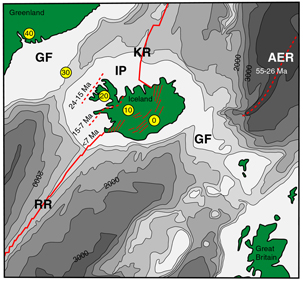
Fig. 1
Bathymetry of the area around Iceland (depth contours
for each 500 m). The position of the Iceland plume relative to
Greenland and Iceland at ages of 40, 30, 20, 10 and 0 Ma is indicated
by the yellow circles. Continuous (red) and dashed (red) lines show the
active and inactive spreading axes. The active rift zones in Iceland
are shown as individual fissure swarms in red colour. RR: Reykjanes
Ridge; KR: Kolbeinsey Ridge; AER: Aegir Ridge; IP: Iceland Plateau; GF:
Greenland, Faeroer Ridge. Map modified after Maclennam (2001) and Kaban
et al. (2002).
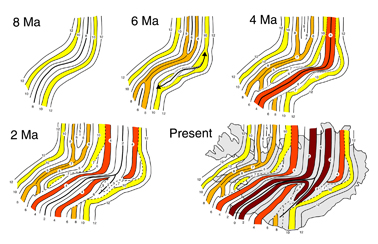
Fig. 2
Crustal accretion,
relocation and propagation of the Icelandic rift zones in the last 12
Ma. The cartoons show map views for 8, 6, 4, 2 and 0 Ma. The 8 Ma
cartoon shows the spreading along the Snaefellsnes and Skagi rift
zones. The 6 and 4 Ma cartoons demonstrate the incipient propagation
and mature development of the Western and Northern Rift Zones after the
new rift initiation at about 7 Ma. The 2 and 0 Ma cartoons show the
southwards propagation of the Eastern Rift Zone, initiated at about 3
Ma. Based on data from Saemundsson (1979) and J´hannesson
(1980) and a synthesis by IVvarsson (1992).
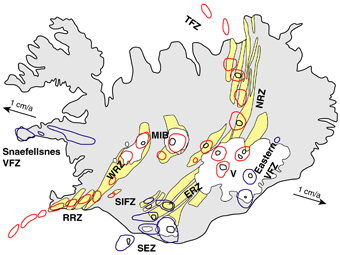
Fig. 3
Volcano-tectonic map of Iceland. Fissure swarms drawn
in yellow. Volcanic centres and calderas are outlined with red and
black lines, respectively. The central volcanic areas of the volcanic
flank zones (volcanic off-rift zones) are outlined with blue lines.
Simplified after Trönnes (2002). VFZ: Volcanic Flank Zone;
RRZ: Reykjanes Rift Zone; WRZ: Western Rift Zone; ERZ: Eastern Rift
Zone; NRZ: Northern Rift Zone; MIB: Mid-Icelandic Belt; SIFZ: South
Icelandic Fracture Zone; TFZ: Tjörnes Fracture Zone; SEZ:
South Eastern Zone; V: Vatnajökull
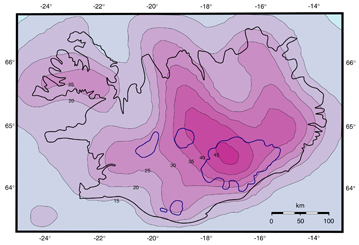 Fig. 4 Crustal thickness beneath Iceland. The
contours show
the depth (km) of the Moho, based on seismic data. Simplified after
Kaban et al. (2002).
Fig. 4 Crustal thickness beneath Iceland. The
contours show
the depth (km) of the Moho, based on seismic data. Simplified after
Kaban et al. (2002).
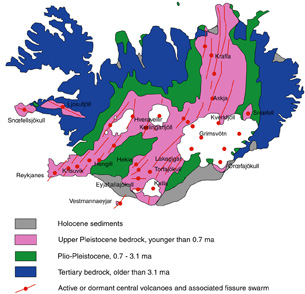 Fig. 5 Simplified geological map of Iceland.
Modified after
Jóhannesson & Saemundsson (1998). The ages of the
rocks increase perpendicular to the rift axis.
Fig. 5 Simplified geological map of Iceland.
Modified after
Jóhannesson & Saemundsson (1998). The ages of the
rocks increase perpendicular to the rift axis.
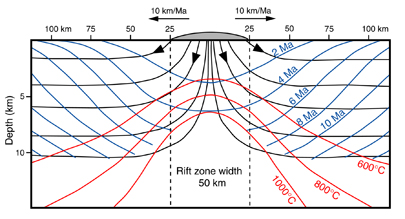
Fig. 6
Simplified model of Icelandic rift zone dynamics and
crustal accretion (redrawn after Palmason 1981). The black lines
represent the mass trajectories, the blue lines the age contours (Ma)
and the red lines the temperature contours (°C).
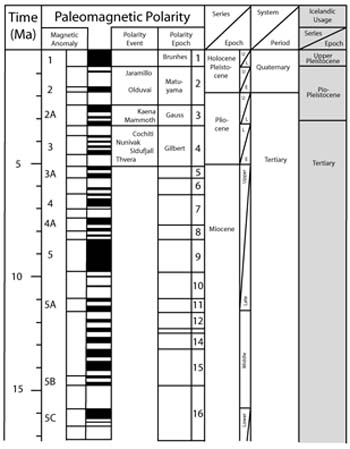 Fig. 7 Stratigraphic timetable modified after
Saemundsson
(1979) and La Brecque et al. (1977). Grey marked column shows the
subdivisions into Plio-Pleistocene and Upper Pleistocene, following the
common usa in Icelandic geology.
Fig. 7 Stratigraphic timetable modified after
Saemundsson
(1979) and La Brecque et al. (1977). Grey marked column shows the
subdivisions into Plio-Pleistocene and Upper Pleistocene, following the
common usa in Icelandic geology.
|